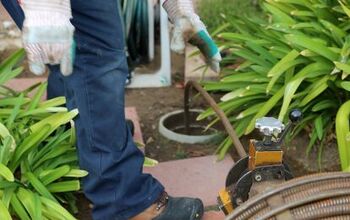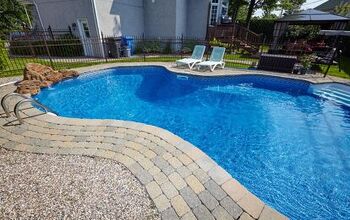Can A Sump Pump Drain Into The Sewer? (Find Out Now!)

A sump pump is a wonderful way to help protect your home investment and keep your property safe and dry. In the event of heavy rains and potential flooding, a sump pump helps to pull water out of your home and direct it safely away from your home. Finding an area to channel the excess water can be a challenge for a new sump pump installation.
A sump pump should drain away from your house, usually about 20 feet or further from the foundation. You can drain your sump pump to a storm sewer, but never a sanitary sewer. In most states, it is illegal to connect your sump pump drain directly to a sanitary pipe.
A sanitary sewer is intended for wastewater to move to the wastewater treatment plant for your city or municipality. Comparatively, a storm sewer will drain directly into the waterways in your local area. Because a sump pump is simply pulling rainwater and floodwater away from your home and redistributing the water to a place away from your foundation, it is perfectly acceptable to allow the sump pump to drain into the stormwater sewer without problem or issue.
Do You Need to Hire Sump Pump Installers?
Get free, zero-commitment quotes from pro contractors near you.

What Does a Sump Pump Do?
A sump pump is a tool that helps to remove water from your home, sending it to an area further away from your property so that it does not continue to cause problems. Many sump pumps are installed in the basement in the lowest-lying area to collect water and pump it away. Sump pumps are then connected to the storm drain or stormwater sewer. Sump pumps require electric power, so having a battery backup or small generator to help run your sump pump if the power goes out is essential.
Where Should a Sump Pump Drain To?
You always want to ensure that your sump pump is draining to the stormwater sewer and never the sanitary sewer. In fact, it is illegal to have a sump pump drain directly connected to the sanitary sewer in most states. Be sure that your drain and discharge point is at least ten feet away from your house, but in most cases, the further away, the better. You don’t want soil close to your home to reabsorb the discharged water, causing it to enter your basement again.
How Can I Tell the Difference Between a Sanitary Sewer and a Stormwater Sewer?
The stormwater sewer is used to collect water from the home when it rains. Usually, storm drains can be found near the streets to flow directly to the area’s waterways. Storm sewers are commonly near curbs, parking lots, or the main roadway.
Comparatively, a sanitary sewer system is connected to the treatment plant and is intended for sewage. These sewage pipes are usually underground near the perimeter of your home. Most main sewer lines are connected to your home underground with a pipe spur that branches off the mainline and is connected with a sewer tap located near your property.
What Is a Storm Sewer?
A storm sewer is a specialized sewer type that is not connected to the central waste management treatment center. Storm sewers are common for foundation drains, catch basins, and roof drains. Often, storm sewers are routed directly into main waterways, so chemicals and water treatment minerals must never be allowed to mix into a storm sewer.
What is a Sanitary Sewer?
Comparatively, a sanitary sewer is a direct route to the wastewater treatment center or municipal sewer center for your city. The water that is channeled to a sanitary sewer is treated with chemicals to reduce bacteria growth within the water. Your home’s toilet, dishwasher, sink, washing machine, and floor drains are all connected to a sanitary sewer to allow the wastewater to flow to the city’s municipal water treatment center.
How Do I Know If I Need a Sump Pump?
Adding a sump pump can be a significant investment, and many homeowners will delay adding this costly plumbing appliance to their homes. However, a sump pump can help save the headache and countless repairs if a flood should occur if properly installed. You may need to install a sump pump if:
- Wet Basement – Even if your basement has never fully flooded before, you may want to consider adding a sump pump if you see moisture starts to accumulate in the basement.
- High Moisture Area – If you live in an area with a high amount of moisture, either from heavy rainfall or from loads of snow annually, it may be a good idea to invest in a sump pump.
- Low Lying Area – If your home is in a valley, at the end of a hill, or in a low-lying area, a sump pump makes sense. Water will naturally flow downhill and collect near your property which could potentially flood your basement.
- Finished Basement – A finished basement has many soft surfaces, including curtains, carpeting, and furniture that can become severely damaged if a flood occurs. A sump pump is a great fail-safe to ensure your basement stays clean and dry even with heavy rains.
- Existing Sump Pump – If you already have a sump pump in your basement, but it is not working, it may be a sign that a sump pump is required and it should be replaced. Having a functioning sump pump is essential if you receive heavy rains that can flood your basement.
How Do I Install a Sump Pump?
Installing a sump pump may be a simple process in some homes, but this is a highly advanced DIY project for many. If you are uncomfortable with any steps, be sure to call a licensed plumber to help perform the work. Installing a sump pump in a finished basement or a basement with a concrete floor may require heavy machinery like a jackhammer so that this job may be better left to a professional.
To install your sump pump in your basement, you should:
Step 1: Locate Low Point
It would be best to have your sump pump at a low point in your basement. Find the lowest point and dig a how that is big enough to accommodate the pump. The top of the sump pump should be level with the floor. You’ll need to use a jackhammer to break through the concrete if you have a concrete basement slab. This job is often better left to professionals.
Step 2: Add Weep Holes (Optional)
At this point, you may want to drill small holes on either side of the basin, called weep holes, which can help channel the water into the basin better. These are not mandated but can often help move water out of your basement more quickly.
Step 3: Use Filter Paper
Line the basin with filter paper. This material will work to trap the sludge and debris, preventing it from entering your sump pump, which could damage the internal workings or cause your pump to become sluggish.
Step 4: Install Float Valve
Adding a float valve to your basin tells the sump pump when to turn on. The float valve will bob at the waterline, and when it reaches a certain point, it will trigger the sump to turn on.
Step 5: Install Check Valve
A check valve is an essential part of the installation, which will be installed on the home’s exterior where the water is drained away from your basement. The check valve ensures that water will only flow away from the sump pump and never back into the sump pump.
Step 6: Test the Sump Pump
Fill the basin with water and turn the sump pump on. When the water level reaches the float valve, it should trigger the sump pump, and the water level should start to go down until all the water is safely drained away from the basin and basement.
Do You Need to Hire Sump Pump Installers?
Get free, zero-commitment quotes from pro contractors near you.

Related Questions
Does a sump pump require maintenance?
A sump pump is a relatively easy tool to use and requires only some simple maintenance performed about once per year. You’ll want to visually inspect your pump to ensure that the gaskets and connections are clean and clear of debris. If your sump pump is regularly used, you may want to check your pump about once per month. Fully disconnect the pump from the power supply and perform monthly cleaning to remove any dirt, debris, or mineral deposit build-up from processing water through the pump.
How much does a sump pump cost?
Adding a sump pump is a pretty significant investment, especially if you do not already have a sump pit in your basement. A sump pump usually requires a lower part of the basement, called a sump pit, to act as a basin catching water. In some cases, a French interior drain is necessary to help channel water to the pump.Installed, a new sump pump installation can cost as much as $3,000 in your basement. But, most homeowners will spend about $1,000 for the job. Compared to the cost of replacing the soft materials in a finished basement, though, even $3,000 seems like a small investment for peace of mind.

We are a team of passionate homeowners, home improvement pros, and DIY enthusiasts who enjoy sharing home improvement, housekeeping, decorating, and more with other homeowners! Whether you're looking for a step-by-step guide on fixing an appliance or the cost of installing a fence, we've here to help.
More by Upgraded Home Team


















![12 Washing Machine Brands to Avoid [with Recall Data]](https://cdn-fastly.upgradedhome.com/media/2023/07/31/9075781/12-washing-machine-brands-to-avoid-with-recall-data.jpg?size=350x220)








